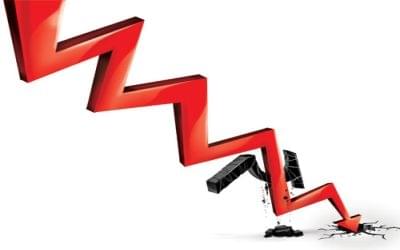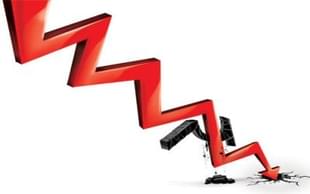Economics
(Mis)Managing the Rupee Fall
Prashant Kulkarni
Jul 02, 2013, 01:30 PM | Updated Apr 29, 2016, 01:28 PM IST
Save & read from anywhere!
Bookmark stories for easy access on any device or the Swarajya app.


Come last week of May, people across Britain gather in Cooper’s Hill, Gloucester England, for an unusual activity. Their objective is to roll the seven pound hulk of cheese down the hill and chase it. With the cheese rolling at times 30kmph, it is not unusual to find chasers getting hurt in their pursuit to be the first to collect the cheese.
This struck me in recent days as both our Prime Minister (PM) and Finance Minister (FM) attempt to catch the rupee racing downhill. While catch, they may or not, it is unlikely the government will come unscathed in the rupee rolling race. Despite claims by FM of the stronger economy, global confidence in India, belief in reining in fiscal and revenue deficit, solace in the fact that other countries too are facing the depreciation, all of these are unlikely to calm down the fears about the Indian economy.
One June 27, 2013, it touched its historical low at ₹ 60.5 /$. On October 5, 2012, the rupee was trading at below ₹ 52 /$. Since July 2012, it has experienced a fall of 27%, one of the worst performances by Asian currencies against the dollar. While a section believes that the current fall in line with similar depreciation of other currencies like Brazilian real (decline of 7% in May), South Korean won (around 2% in May), Russian ruble (around 3.5% in May), it explains only part of the picture. Similarly, the explanation that rupee has actually gained in real terms (weighed against relative inflation) against the dollar (you can see the explanation here) too does not give solace.
Rupee depreciation occurs when a demand for dollars exceeds supply. Since 2008, US Fed has followed a policy of quantitative easing (QE). This, involving buying bonds in the open market, has ensured a steady flow of dollars into the open market. Further QE was aligned to the low interest regime aimed at bringing the United States out of the economic slowdown. Recently the Fed announced the tapering its bond purchases in the coming months. This will result in the release of fewer dollars into the market.
Fed tapering is just an immediate cause for the fall in the rupee (Read about Fed tapering here). As the confidence in other currencies reduces, bond traders might flock to purchase Fed securities, increasing the possible appreciation of the dollar vis a vis other currencies.
In contrast, both European Central Bank (ECB) and Bank of Japan (BoJ) have focused on QE. Eurozone is again showing signs of slowdown and if the emergent data were to fall below expectations, ECB might go in for further monetary easing. This coupled with fears of loss of confidence in Euro might push investors into hands of the dollar. Yet, it would be naïve to ignore other underlying domestic causes of the rupee depreciation story.
Investment, capital creation in the economy, is financed through domestic savings either household or government. Household savings are generally constant. In a situation where the government runs a deficit (dis-saving), the economy is compelled to sources the savings of the rest of the world to sustain the level of investment. In other words, surplus dollars that exist in the rest of the world are sourced to finance domestic investment. Thus, high fiscal deficit results in high current account deficit (CAD) causing a situation termed as twin deficit paradox. The 1991 crisis in India is generally attributed to the twin deficit paradox.
The fiscal deficit is projected to be 4.9% of the GDP for the current fiscal year. The revised projections for 20012-13 were 5.2% while actual for 2011-12 was 5.7%. The combined state and central deficit is likely to touch 10%. Revenue expenditure forms nearly 85-90% of the total government expenditure. Revenue expenditure is incurred on the normal running of government departments and various services, interest charges on debt incurred by the government and subsidies.
Broadly speaking, expenditure which does not result in the creation of assets is treated as revenue expenditure. Revenue receipts comprise largely of tax receipts and difference between revenue receipts and revenue expenditure is a revenue deficit. Currently, revenue deficit is around 3% of the GDP. In other words, government has to borrow to meet even its day to day needs and thus a sure red flag.
Decomposing revenue expenditure, subsidies constitute just about 20% in the revised estimates last year. It is projected to be around 16% of the total expenditure for the current fiscal. Interest payments account for a quarter of the total expenditure. Given the elections ahead, ambitious plans about food security etc, the expenditure is likely to increase further. Food security expenditure alone is likely to increase expenditure on subsidies by more than ₹400 million (link between food security bill and the deficit here).
Simply put, CAD exists when we import more than what we export. The deficit has to be financed through capital account surplus (foreign investment, external commercial borrowings, external grants etc). Normally currency depreciation results in exports being competitive and thus good for the export oriented economy.
China has deliberately kept Yuan weak to reap the advantages of its exports to US. Despite rupee fall, exports have fallen. The Eurozone crisis has depressed the exports. Further exporters are under pressure to quote lower prices to global clients. It is unclear yet how the windfall, the economic exposure will result out of the depreciation. Besides the J-Curve effect will also set in the short run worsening the Balance of Payments (BoP).
Indian oil imports account for around 30% of the total imports. Gold imports are 10% of the total commodity imports. With the oil being relatively inelastic, it is unlikely to see a downturn in terms of imports. Further gold imports are a symptom of the malaise and not the disease. As the confidence in the rupee falls, there will be a movement towards safer investment avenues and gold and land are definitely the prominent.
Further in countries like India, poorer sections of society who do not have access to banks and other investment avenues invest their savings in gold. Even among the well-off, gold investment counts high. Yet in macroeconomic terms, it represents a withdrawal from the economy and hence a dead investment. Besides, coal imports have doubled in the last couple of years whereas fertilizer imports has increased by 30% over the last two years.
Besides, higher inflation relative to other countries, result in imports becoming relatively cheaper. Thus higher imports and lower domestic consumption pull down aggregate demand. The low growth rates (fears about India growing less than 5% per year) deter foreign investors from parking their funds in India.
A short term solution would be to draw down the existing foreign reserves to increase the availability of dollars in the market. RBI intervened on a couple of occasions, but an anecdote on the Thai crisis of 1998 would be in order. While discussing at length, Thomas Friedman quotes a conversation with the then Thai Deputy Prime Minister Supachai Panitchpakidi in his book Lexus and the Olive Tree.
As Mr. Panitchpakidi puts it, not allowing the natural depreciation of the currency was one of the causes of the crash. The Thai Central Bank drew down from the foreign exchange (forex) reserves each time there was a pressure on the currency. Every intervention decreased the reserves and when there were very little reserves to defend, the speculators mounted an attack and caused a massive crash in the Thai Baht. Currently, forex reserves in India are estimated to cover barely 7 months of imports. Any drawing down of these reserves can result in speculators mounting fresh attacks on the currency.
RBI’s decision on changing benchmark interest rates also has its downsides; interest rate cuts might increase inflation and deter investors on account of lower returns. An increase in the rate might slow down growth further, something which the government would not want closer to elections.
This may also spark off increased external commercial borrowings taking advantage of interest rate differentials. An option would be issue dollar denominated bonds to Non Resident Indians (NRIs) similar to Millennium India Bonds or Resurgent India Bonds issued in 1998-99. This will stave off the present crisis for some time.
But the bottom line remains: No option but to drastically reduce the fiscal deficit. This calls for a strong reform mindset. The government has to abandon the food security bill. Further it has to scale down expenditure on rural employment guarantee scheme and evolve an alternative mechanism.
A strong move towards disinvesting in select Public Sector firms (PSUs) can restore the confidence in the market. As government expenditure reduces, the confidence in the rupee gets restored. To depend on the monetary element to cure the current ills is to pass the buck. The government has to own the buck. Unless there is strong correction course, a repeat of 1991, cannot be ruled out.
Prashant Kulkarni teaches economics, a digital economy and globalization at a leading B-School. His area of interest lies in dissecting resource contestations and human behavior at the intersections of digitization, urbanization and globalization.





